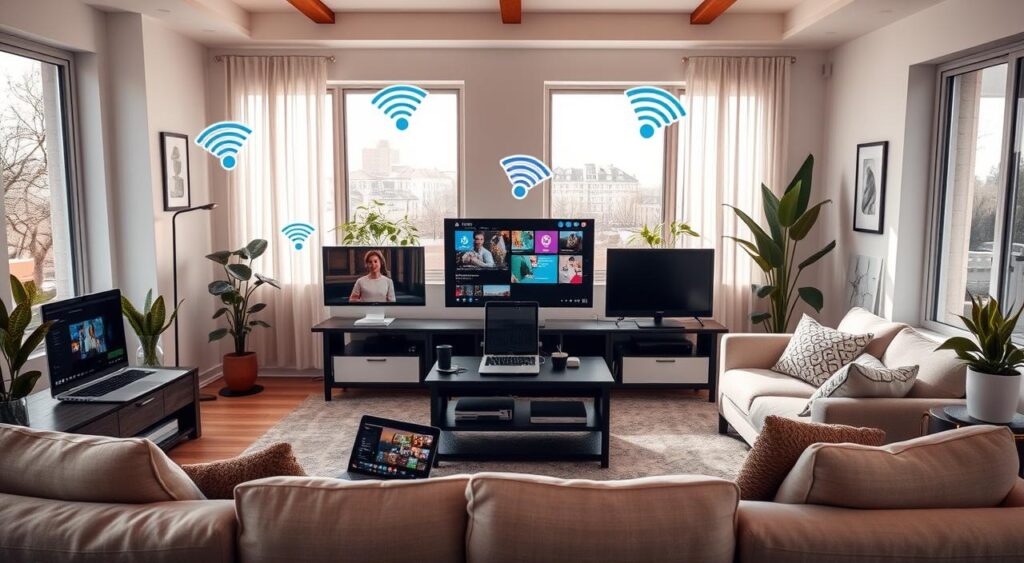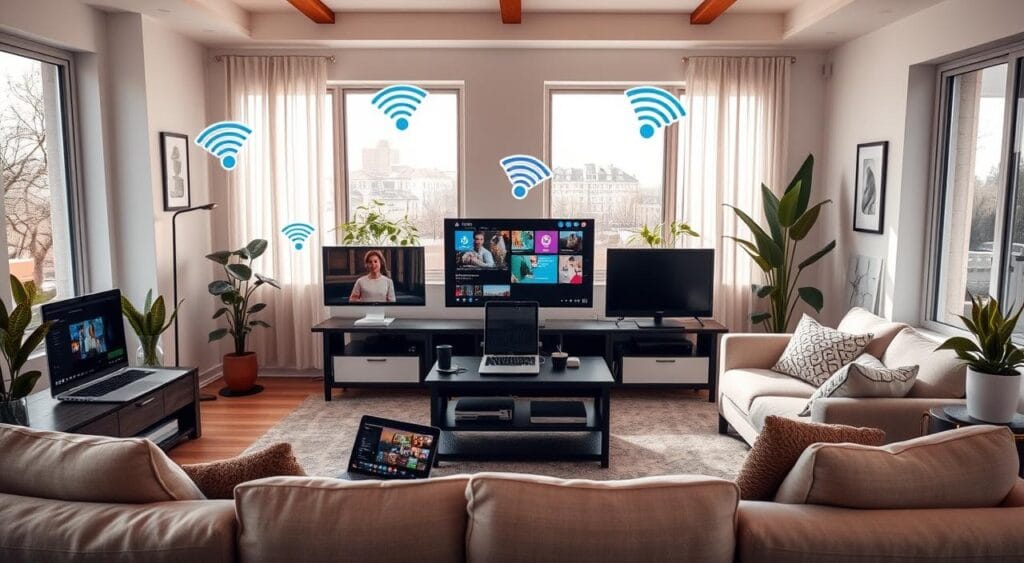In today’s world of Residential Broadband Internet services is more important, and fast internet is a must-have for homes in America. It’s needed for streaming, video calls, and remote work. This article will help you pick the best internet plan for your home.

Key Takeaways
- Understand the basics of broadband internet and its benefits for home use.
- Assess your household’s internet needs to find the right plan.
- Explore the various residential broadband internet providers in your area.
- Consider speed, bandwidth, and data caps when choosing a plan.
- Learn about the different broadband internet technologies available at home.
Understanding Residential Broadband Internet
In today’s world, fast and reliable internet is a must for homes. Broadband internet means using advanced tech for quicker, more stable, and flexible internet. This part talks about broadband internet and its benefits for home use.
What is Broadband Internet?
Residential Broadband Internet covers many high-speed internet types, like DSL, cable, fiber-optic, and satellite. Each uses a different way to send data, with its strengths. Broadband internet is much faster than dial-up, making it great for streaming, gaming, and video calls.
Benefits of Broadband for Home Use
Having Residential Broadband Internet at home brings many perks. It lets you easily access lots of online stuff, making work, fun, and talking to others better. Key benefits include:
- Quicker downloads and uploads so that you can get to websites and files faster.
- Being able to work from home, team up online, and use cloud apps.
- More fun with streaming, gaming, and video chats.
- Better talking with video calls, social media, and messaging.
- More access to online learning, shopping, and digital services.
With Residential Broadband Internet, homes can open up to new possibilities. It makes life more connected, efficient, & fun:

Choosing the Right Residential Broadband Internet Plan
Choosing the perfect broadband internet plan for your home is important. It would help if you thought about how many devices you have and what you use the internet for. Also, consider the speeds you need for a smooth online experience.
Assessing Your Internet Usage Needs
To pick the right plan, look at a few things:
- Number of devices: Count all devices that will use the internet, like phones, tablets, laptops, smart TVs, and gaming consoles.
- Online activities: Think about what you do online, like streaming, gaming, video calls, or working from home. Each activity needs different speeds.
- Download and upload speeds: Decide on the minimum speeds you need for your activities. This will help avoid slow connections.
By considering these points, you can choose the Residential Broadband Internet plan that fits your home broadband plan requirements and assessing internet needs. This ensures a fast and reliable internet connection for your household.

“Choosing the right broadband plan is essential for ensuring a smooth and reliable internet experience in your home.”
Residential Broadband Internet Providers
Choosing the right broadband internet for your home can be tough. There are many options, from big national companies to local ones. Let’s explore some of the top residential broadband providers, top broadband internet providers, and local broadband internet companies you might find in your area.
National Providers
The big names like Comcast, AT&T, Verizon, and Spectrum cover the whole country. They offer a variety of plans, from fast to super-fast fiber-optic. You can also get a TV and phone with your internet, saving money and time.
Regional and Local Providers
There are also local broadband internet companies for specific areas. CenturyLink, Frontier, and Cox Communications are examples. They might offer better customer service and prices than the big guys.
When looking for residential broadband providers near you, compare plans and speeds. Also, check data limits and how happy customers are. This will help you choose the best for your home.
“The right broadband internet provider can make a world of difference in how you experience the online world.”
Factors to Consider When Selecting a Plan
Choosing the right Residential Broadband Internet plan for your home involves several key factors. It’s important to understand your household’s unique internet needs. This helps in picking a plan that offers the best performance and value.
Speed and Bandwidth Requirements
Speed and bandwidth are crucial to consider. The download and upload speeds, and the total bandwidth needed, vary based on several factors. For example, streaming HD videos, video calls, and online gaming require more bandwidth than just browsing the web or checking email.
Data Caps and Unlimited Options
Data caps and unlimited plans are also important to think about. Data caps limit your monthly data use, leading to extra fees if you go over. Unlimited plans, however, let you use as much data as you need without worrying about extra charges.
| Broadband Plan Feature | Importance | Ideal Scenario |
|---|---|---|
| Download Speed | High | Minimum 25 Mbps for a household of 2-4 people |
| Upload Speed | Moderate | Minimum 5 Mbps for a household of 2-4 people |
| Data Caps | High | Unlimited data or a high cap (500 GB+) |
By evaluating your speed needs, data usage, and unlimited options, you can find the perfect plan. This ensures a smooth online experience for your household.
Residential Broadband Internet Technologies
Choosing a Residential Broadband Internet plan for your home requires knowing the different technologies. We’ll look at DSL, cable, fiber, and satellite options.
DSL (Digital Subscriber Line)
DSL uses the phone lines to bring broadband internet to your home. It offers speeds from a few Mbps to over 100 Mbps. The speed depends on the provider and your location. DSL is reliable but can slow down with distance from the nearest exchange.
Cable Internet
Cable broadband uses the same cables as your TV. It’s faster than DSL, reaching speeds up to 1 Gbps. Cable internet is known for its consistent performance, making it great for homes needing fast speeds.
Fiber-Optic Internet
Fiber-optic internet, or fiber internet, uses fiber cables for speeds up to 10 Gbps. It’s reliable, has low latency, and is future-proof. But, fiber might not be as common as other options.
Satellite Internet
Satellite internet uses satellites to reach remote areas. It’s an option when wired broadband isn’t available. But, it has slower speeds and higher latency than other broadband internet technologies.
When picking a broadband internet plan, think about your internet use, available options, and the technology’s performance and reliability.
Setting Up Your Residential Broadband Internet
Getting your new home broadband connection set up is exciting. It opens up the world of broadband internet in your home. The broadband installation process can differ based on your provider and technology. But, there are common steps to connect your home to broadband.
You’ll need the right equipment, like a modem, router, and cables. Your ISP can tell you what you need. They might even give you the equipment as part of your plan.
- Unpack and connect the modem as directed by your ISP.
- Set up your wireless router, if applicable, and connect it to the modem.
- Configure your home network settings, such as passwords and network name.
- Connect your devices, like computers, smartphones, and smart home devices, to the wireless network.
- Test your internet connection by visiting a webpage or streaming content.
If you run into problems during setting up home broadband, reach out to your ISP’s customer support. They can help and fix any issues. This ensures your broadband installation goes smoothly.
“A reliable and fast home broadband connection is essential for modern living, enabling seamless access to information, entertainment, and communication.”
By following these steps, you’ll enjoy the benefits of your new Residential Broadband Internet service.
Optimizing Your Home Network for Broadband
To get the most out of your home internet, you need to optimize your network. Place your router in a central spot, away from things that might mess with your signal. Make sure your devices work well with the latest Wi-Fi standards.
Put your router in a place where it can reach all areas of your home. Avoid putting it near things like microwaves or cordless phones. Also, get a new router that supports the latest Wi-Fi. This will give you faster speeds and a stronger signal.
Reducing Wi-Fi interference is important. Look for and remove any sources of interference, like other wireless networks. Use tools to find the best channel for your router. Also, make sure all your devices, like phones and laptops, are up to date with the latest Wi-Fi standards.
